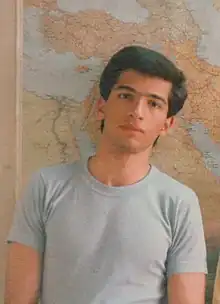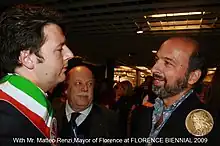Amir Shayesteh Tabar | |
|---|---|
 | |
| Born | 7 April 1967 Tehran, Iran |
| Notable work | Blue Symphony, Violin, War and Peace, Silence of the Universe |
| Movement | Peace Tour By Blue Symphony |
| Awards | "Lorenzo il Magnifico" award from Florence Biennale 2009 |

Amir Shayesteh Tabar (Persian: امیر شایسته تبار; born 7 April 1967) is an Iranian artist, painter, poet, and filmmaker. Shayesteh Tabar is best known for "The Blue Symphony," a collection of computer graphic artworks that use the words of the Basmala, بسم الله الرحمن الرحيم (translated as "In the name of God, the most graceful, the most merciful") to create geometric patterns. Beginning in the 90s, Shayesteh Tabar spent more than 16 years on the completion of "The Blue Symphony" and four years for the calibration of the colours alone.[1] The artist's hallmark is his meticulous attention to details while targeting major social, cultural, or political themes such as the concept of the divine, world peace, or the significance of art in society.
On 30 September 2022, it was announced by the curatorial committee of Florence Biennale that the motto for the 14th edition, which took place in Florence, Italy, from 14 to 22 October 2023, would be "I am You - Individual and Collective Identities in Contemporary Art and Design" and that the event would be in large part dedicated to the struggle of Iranian women for their rights. On this occasion, Florence Biennale signed an international petition initiated by Shayesteh Tabar, calling for an increased engagement on behalf of the global community of artists to support the cause of the Iranian people as "true artists" and to become the "voice of those who are left without any help".[2]

Early years
Shayesteh Tabar is a Persian Iranian, born into a simple family in Tehran. His parents were originally from Tabriz, but moved to Tehran during the Second World War. His father was a merchant working as a wholesaler at the food market. Shayesteh Tabar received a BA degree in Industrial Management from Allameh Tabataba'i University in Tehran. During his time as a student he dedicated more of his time to studying and practicing arts, including photography, poetry, calligraphy and history of arts, than to his university subjects. He went on to attend painting classes offered by Iranian masters Rouein Pakbaz, Bahram Kha'ef, and Mehrdad Moheb-Ali,[3] but stuck to his decision to continue working as a self-taught artist.

During his time of studying of Islamic art, he realized that after the Islamic Golden Age, most of the Islamic designs created around the world began to follow the same patterns and outlines, continuing for centuries. This eventually fueled to his desire to become a source of innovation in the field of Islamic Arts.

Artistic features
Shayesteh Tabar uses specific religious phrases of the Quran, written in the Perso-Arabic script, Nastaligh, to form intricate geometrical patterns and an illusion of dimension through color. Other cultural influences of Shayesteh Tabar can be traced back to traditional art from India, Morocco, and the Baroque period of Western Europe.[4]
Shayesteh Tabar has been an early advocate for the digitization of the arts by pointing out the advantages digital artworks have over their physical counterparts, namely their accessibility, transportability, indestructibility, scalability and verifiability through the use of digital storage tools and the recent blockchain technology.[5]
Shayesteh Tabar describes it as his "dream to see these patterns used for cityscapes, buildings, mosques, interiors, jewelry, fashion garments, carpets, and other objects. "For the Islamic world, this is about reaffirming our identity, bringing children in touch with our rich artistic history, and absorbing fine art in life to create beauty and harmony outside and within."[6]

Vision
Shayesteh Tabar's professional approach is rooted in the belief that art should be widely accessible, enjoyed by all, and protected from censorship. He envisioned the revolutionary potential of the application of digital technologies in art as early as the early 1990s. He reasoned that, particularly through the use of blockchain technology, the authenticity and non-fungibility of digital creations could be guaranteed while making it possible for artworks to be preserved in the digital space theoretically forever.

Exhibitions
Shayesteh Tabar held several solo exhibitions in various countries around the world[7] and was awarded the President's Award "Lorenzo Il Magnifico" at the 2009 Florence Biennale for his unique approach and contribution to the arts with his Blue Symphony collection.[8]
Blue Symphony Foundation plans
Shayesteh Tabar intends to create a Blue Symphony foundation that will pursue his vision of arts without borders, with world-class art available to everyone and intellectual properties being protected through the use of blockchain technology. The foundation aims to encourage young people, especially those from marginalized parts of society, to become involved in the arts and to become creators of their destinies.
Furthermore, the foundation seeks to implement peacemaking initiatives that foster intercultural and interreligious dialogue and a more conscious use of society's resources.
References
- ↑ "Амир и «Голубая симфония» - Аналитический интернет-журнал Власть". vlast.kz (in Russian). Retrieved 29 September 2022.
- ↑ Redazione, Di (30 September 2022). "XIV Florence Biennale: "I am You" è il tema scelto per l'edizione 2023. Il sostegno alle donne iraniane - Arte Magazine" (in Italian). Retrieved 1 October 2022.
- ↑ "archive.ph". archive.ph. Archived from the original on 9 September 2012. Retrieved 29 September 2022.
{{cite web}}: CS1 maint: bot: original URL status unknown (link) - ↑ Павлова, Надежда (8 June 2012). ""Голубая симфония"". www.forbes.kz. Retrieved 29 September 2022.
- ↑ Didacus (25 August 2019). "Art on the blockchain: my experience with the Blue Symphony Collection". Publish0x.
- ↑ "Spiritual art with a purpose". gulfnews.com. Retrieved 29 September 2022.
- ↑ "Выставка иранского художника Амира Шайестех Табар «Голубая Симфония» проходит в КИМЭП". www.caravan.kz (in Russian). Retrieved 30 September 2022.
- ↑ "Almaty: Digital Art and the World at 7 Billion ..." 7 Billion Actions: Blog!. Retrieved 30 September 2022.